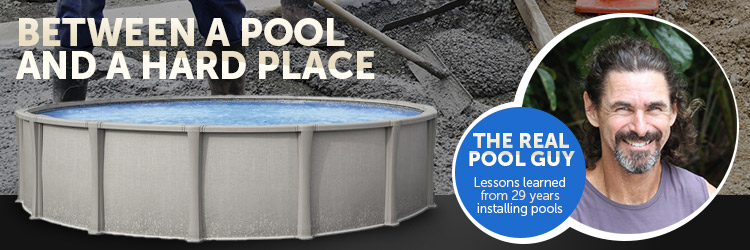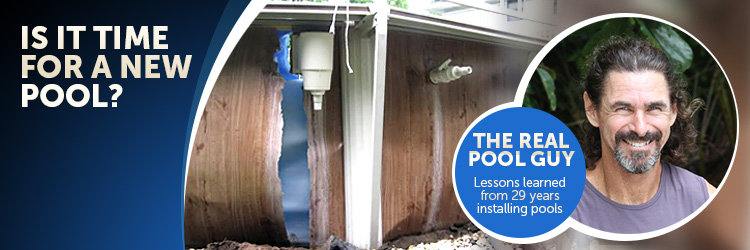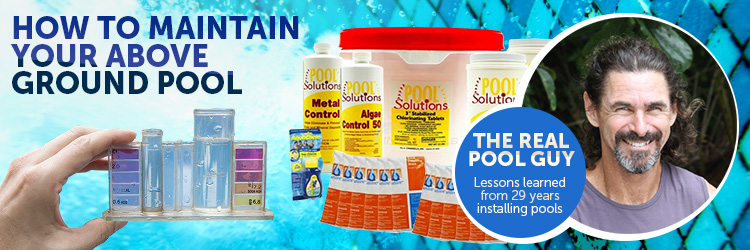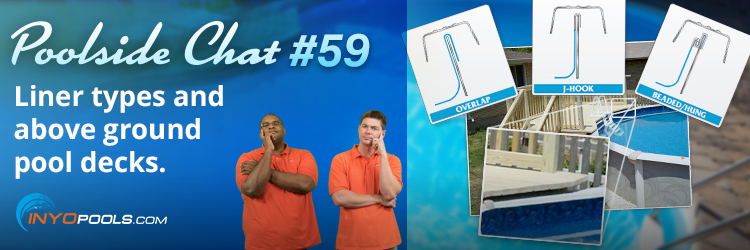The vast majority of above ground swimming pools are built directly on the ground. In some areas of the country the ground is too hard as it is mostly rock or hard clay. These areas have to be dug up and/or chipped away into a flat area and then sand or limestone is brought in for leveling. In these areas, the price to have the pool installed is considerably more because machinery and materials are needed to get the ground level and the pool’s bottom flat and smooth.
Here in Central Florida (yeah, that’s where I am), installations are easier because our earth is mostly sand. I use a skid-steer machine to level the ground, because I’m now older and smarter, but most installers don’t use a machine. I always state that when you are installing an above ground pool, preparing the ground is half of the job. Preparing the ground and pool’s bottom requires most of the craftsmanship.
It is truly an art form when it comes to getting an above ground pool’s bottom flat and smooth using just the earth and/or added material. After about 25 installations, most new installers have learned to build an above ground pool’s structure pretty well and can even get the liner somewhat free of wrinkles too. Making a smooth and flat bottom is a different story. I have to say it probably takes an installer who values quality a couple hundred installations before he becomes somewhat proficient at making a nice flat pool bottom.
A flat, smooth pool bottom isn’t a must-have, but it does make your pool much nicer to use and keep clean. Above ground pool bottoms with sharp objects pointing up, and bumps and dips and footprints usually won’t cause any issues. It will only feel different to your feet and be more challenging to vacuum. Simply using an OK installer instead of one with twenty-nine years of experience (shameless self-promotion) will make all the difference if you want to have a nice pool bottom.
So why all this talk of earth-based pool bottoms when the title of this blog post is about installing on concrete? Well, I’m just getting you prepped for why you would consider putting your above ground on concrete. It’s really rare for people to decide to install their pool on concrete mainly because of the cost. There are advantages to doing this so if you are thinking about it and have the money, then here are some things you need to know.

Five Reasons Why You May Want to Install Your Pool on Concrete
Let’s start with why most people elect NOT to install their pool on concrete. The reason is – money. Concrete is expensive! It is really expensive. How much you ask? Well, it’s hard to say exactly as it depends on the size of the pool, what town you live in, and what your earth consists of and how much leveling is required. Keep in mind that you still have to prepare the ground by making it level to within at least a couple of inches or less so whatever that takes will add to the price. The price of concrete and concrete work varies. It depends on where you live. So, to find out a ballpark figure, call a couple of concrete guys and ask about the price for about a 500 sq ft level slab (that’s good for about a 24’ round pool). When you are done shrieking, remember I told you it’s pricey.
1. A Concrete Pool Bottom Is Nicer Than an Earth Bottom
If you only read the headlines of this blog post, then go back and read the beginning. I am an artist at making an earth or sand bottom clean and smooth and flat, but even I am no match for concrete. Concrete starts out like liquid and then slowly gets harder and harder. This is why you can get it really flat and smooth.
2. Nutgrass Cannot Grow Through Concrete
In a lot of areas, nutgrass or nutsedge (look it up) is an issue for above ground pools. I’ve seen nutgrass grow through heavy-duty tarps, gorilla pads, high-density foam boards, and then of course, pool liners. Some products boast that they can prevent nutgrass from damaging pool liners and maybe some can. Who knows? There is one thing I know for sure and that is nutgrass cannot grow through concrete. Period.
3. Moles Cannot Cause Ruts in Concrete
Moles don’t pose a huge problem for above ground pools, but for some they are a destructive pain in the bottom. They can burrow under a pool and cause trails and ruts everywhere messing up that beautifully smooth bottom I made. It’s rare, but over the years I’ve had a few pool owners have no choice but to pour concrete for their pool bottom because of their extreme mole problem. It’s an expensive fix, but works 100% of the time.
4. The Shifting of the Earth, Decomposing Roots, Horned Nosed Beetles, Termites, and Ants Can’t Affect a Concrete Bottom
This is a general reason. The earth is a dynamic place that has movement and living things that move and eat and destroy. A concrete barrier between the liner and this environment blocks all of earth’s drama.
5. Concrete Doesn’t Wash Away
Above ground pools usually don’t have many issues with leaks until the liner gets old and brittle. At that point it’s time for a new liner so it’s OK for the leaking water to wash some of the smooth earth away as the bottom can get resmoothed when you change the liner. Leaks can happen earlier than that though and they can cause divots in the pool’s earth bottom. It’s not a big deal but it does take away that nice flat bottom you started with in some areas. Concrete doesn’t wash away. No matter how much the pool leaks, a concrete bottom will never change and will always be as flat and smooth as it was on day one.
Getting a Concrete Bottom for Your Above Ground?
Here is some information you’ll need.
- It doesn’t matter whether you get a brushed or smooth concrete bottom. You are going to need foam coves and a liner guard/gorilla pad. Liners that sit directly on concrete are problematic and cause leaks.
- Planning on using an existing slab? Remember it’s got to be level. Outdoor concrete slabs all have slopes for rainwater to drain away. If the slab has a slope that is greater than an inch, you’ll somehow have to make it level.
- Pour the concrete slab first and then build the pool on it. Don’t build the pool and then pour concrete inside the pool’s wall. Why not? Ask me at notagoodidea.com.
- Make your slab level and at least a foot bigger all around than the dimension of your pool’s size. Example: A 24’ round pool should have a 26’ round concrete slab.
- Planning on putting an oval-shaped pool on concrete? Don’t bother. It is too much of a pain.
- You’ll absolutely need to have a lot of cash or credit.












I have a question, we have built the concrete slab to put our pool, but how do we install a pole pool on it. Do we need to use pavers for the braces, and how do we attach the tall poles that came with our pool. Thanks a bunch for your information.
I have a question. Last summer my 24 foot round above ground pool collapsed. I have just gotten a 27 foot round pool. The old pad of dirt from the old pool is packed hard with a few cracks in it. We were planning to set the new one up ourselves. One of the main friends we have to help wants to just add sand to make up the difference for the bugger pool. My concern is when the added sand to make it for a 27 foot settles that it may cause issues and cause the walls to collapse. Should we dig up all the dirt and start over or is this man correct in just adding the difference to make up for the 27 foot pool? Also his first thoughts were to pour Sakrete to accommodate the 27 foot pool. I didn’t think the weight would hold with Sakrete. But now after reading this thread I’m thinking I may check into this. But if it’s too expensive should we redig the entire old pad and start fresh or pack sand around the old pad to make up the difference. Thank you so much for any help. I’ve been searching all over the Internet until I found you. Please and thank you.
My ground settled on one side after leveling, and my Intex pool would ’empty’ when it rained, by about a foot or so. I want to put in a concrete slab to help level the area for the pool this year…is there a tolerance level for leveling the ground before concrete and how thick would be sufficient to hold a 20′ diameter pool 4’deep?
For the cost of the concrete, I would say to see how much it would be to buy a real above ground and install it properly on level ground. If you are set on dealing with an Intex pool though, I don’t think you have to worry about ground tolerances before the concrete. And unless your yard is a swamp or there was a mild earthquake, your earth didn’t settle that much. More than likely, you did a poor job leveling the earth before the install. You are going to have to level the earth really well before pouring the concrete though so maybe after that, you don’t need the concrete after all. Know what I’m saying here? And 2″ thick is probably all you need as the slab will probably crack anyway.
We had a 16′ x 32′ in ground pool with a deep end that we filled in with sand 20 years ago. It has concrete totally around the pool. My question is. Can I install a 15′ x 30′ pool buttress free on top of the old in ground pool? I need some advice on what I can or should not do. Thank you kindly.
Yes you can but it’s gonna be a tough install. You’ll need to make room for the new pool’s buttress structures which will more then likely run into the old pool structure. This means cutting out just the areas of the old pool that you need the extra room for. Honestly, that sounds like more fun than I would want to have.
I am getting a pool that is 18ftx9ftx52 inches. We are placing it on our patio as we have a very small backyard. My concern is the patio is sloped, about 3/4 to 1 inch across 9 feet (the patio is 16 feet wide). I was considering building a frame and leveling it with crushed gravel. Is this the only way to do it? Will the supports of the pool eventually sink into the gravel? Would I need to secure the frame to the patio? The hope is to not have to drill into the concrete.
The easiest way to put the pool where you want it is to build a big sand box with about 4-6 inches deep of sand. Build the pool on that. It won’t move as long as the sandbox doesn’t come apart years from now.
Dan, I have a similar situation to Rob above except trying to install an inexpensive Coleman 18′ round pool on existing 18×18 patio section which has a fair amount of pea gravel floating on surface (not smooth concrete). My biggest concern is the existing slope for drainage: how much slope is considered too much and why?
I like the sand box idea, both for leveling and smoothing out the rough pea gravel concrete surface…
The pool being off anything more than an inch can give you issues. At one inch off, your eye begins to see the off level. At two inches off, a soft sided pool starts to slowly lose its shape towards the low spot. At three inches off, the pool will lose its shape enough to start spilling over the low side.
I had this problem last year, a rectangular soft sided intex pool. There was always spillover, the pool couldn’t hold its shape. Circular pools on a patio that has minimal sloping seems ideal. So, I’m considering doing the above ground pool thing again. What would be the best solution for creating a level surface on a sloped patio? Thinking plywood and shims. My patio is 10′ deep by 20′ wide. No idea how much of a slope I’m dealing with, but it should be whatever is code in my area.
I have a garage that is pretty old and the roof is Failing, the inside slab it sits on is level, it is cement block walls and technically it sits on a slope so part of it is underground. i plan on removing the roof of the garage and some of the block down to ground level basically using the remains as a retaining wall……Anyone have any thoughts ?
Eddie, is there a question here about a pool? I’m a pool guy, not a mason.
Have a trick question. I’m looking to make an above ground concrete lap pool. Dimensions are 36′ long 8′ wide and 4′ deep.
Great article. Now I want to keep this truly ABOVE ground pool but I get that I might need to have a portion of that 4′ height in ground in order for it to settle on level ground. How many inches do I need to excavate? Also do I need to use rebar as a foundation?
Thanks
I have a concrete pad bigger enough for 2 12x24x52. Question Shopping list? With that much concrete is there a problem?
I need a list of all items for a good brand 12x24x52 and all stuff needed for a good set up.
I’d like to get a solar cover to keep it warm in Southern Nevada. It gets hot in summers. But, like to use most of the year. Email information jeffc7198@aol.com
No problem with the concrete. Make sure its level enough though. And I have calluses on my hands so you’ll have to get your list from someone who gets paid to sell pools. I only get paid to install them.
Hello Dan,
I am having a galvanized steel framed 15′ x 48″ Intex (model 28235EH) above ground pool installed on top of cement pavers, which were already in place. What should I put in between the pavers and pool to keep both protected? My concern is the water may stain/damage the pavers (if/when I want to remove the pool), and I want the pool liner & frame to last as long as possible. I also do not want the flooring to be uncomfortable when standing inside the pool. Thank you so much for sharing your expertise with all of us.
Stay Cool! Marianne
I guess just the cheap tarp that comes with the pool will do.
Hello my husband bought an above ground swimming pool it came with an green liner to go under the pool he said that since it was on concrete he wouldn’t have to put it down I think it was supposed to go down is he right or am I right not meant for i am right and he is not just a question
My guess is you have an Intex pool or soft sided pool? If so, then he is right. You don’t need to put that extremely thin and cheap tarp down that it comes with.
My whole backyard is covered in concrete. It appears to be level. Can I put an above-ground pool directly on top of the existing slab or do I need to put some sort of protective barrier down between the slab and the pool?
Thanks for asking, GiGI. I have the same question. My fear is that my concrete backyard isn’t poured thick enough to hold a large pool so I was just going to get a small rubber or soft sided pool that fits 4 or 6 people. I was told a couple times that concrete can’t bear much weight so I’m even worried about this small pool being too heavy. Dan, do you have any suggestions?
How thick is your concrete? Is it cracking because it’s so thin? Regardless, you can put a pool on concrete as long as you have the foam cove and a protective pad, or styrofoam sheeting, or a rug, or something to protect the liner from the concrete surface. If you think about it, most above ground pools set directly on the ground and if installed right, don’t go anywhere. Why would a thin layer of concrete go somewhere when the ground beneath it doesn’t?
Dan, my question is about the cove for my above ground pool that sits on a concrete patio. Its not a slab of concrete. It looks more like brick patio cemented together. I have a 5k LB pool 16ft in diameter. I assume this will hold up with the weight yes? Also I have a soft sided pool! So how would you install a pool cove when there’s no pool wall to tape the foam cove to? Do I just fill the pool and slide the cove around it?
Yes. You do need a liner guard and foam coving though.
We are installing out pool on concrete had the pool place tell me to use a liner guard and happy bottom is the necessary in your opion
Actually I need to ask a question, we are going to put our pool on concrete, and my son wants to paint a rubber coating on it before putting the pool on it, but I think that we still need to put a pad on it also to protect the liner, will the rubber sealant work without the pad or should we still need to put a pad on it also. Thanks
I have no clue if the rubber paint is good. I do know that sometimes liners don’t react or last well next to petroleum based products. I say get the liner pad and foam cove and forget about the rubber.
Why shouldn’t an oval-shaped pool be put on concrete? Just curious.
But my main question is, we are going to be removing an outdoor hot tub from our back deck which is sitting on an existing 10×10 concrete slab. We want to replace the hot tub with a 9×18 rectangle above ground pool. Do you have any suggestions on how we should build onto the 10×10 existing slab to make it large enough for our 9×18 pool?
Thanks!
Hi. If you read the article, it will tell you why. Jus’ Sayin’. And you are asking how to make a 10’x10′ slab large enough for a 9’x18′ pool? Ummm, Add more concrete or pavers to accommodate the pool’s structure? I have no idea why my girlfriend calls me “captain obvious”.
This article addresses concrete… but what about pavers? We have a large paver patio and would like to set up a 12 x 30 Intex Prism/metal frame OGP. What challenges do you think we will face with pavers? (We plan to have the pool set up for the summer but to take it down for the winter.) Thanks!
I wouldn’t trust pavers because they are individual pieces that can shift/sink/break and the possibility of puncturing your liner great increases.
Pavers are fine. I’ve put several pools up on existing pavers. Make sure the area is level. Some patios have a slope for drain-off.
Hi! Thank you for all your guidance. On a paver patio, what could we put under the pool to accomodate for the gradual 2” slope?
Hi, Lacy: I’m in “Sunny” South FL and have had my 14′ Round pool on an existing concrete patio for 1-year now, however, that 2″ slope issue has been bothering me. Did you receive any suggestions?
The wall of the pool has to be level. The rest of the bottom does not. You could use wood shims under the bottom connector plates on the lower side of the pool to make the bottom track level. Then, if you want to be fancy, you could spray foam under the track to keep in in place if the wood rots later. After the track is level, install the wall and install the foam coving. The pool bottom with be 2″ lower on one side but the pool will be level.
So how do I level the ground on concrete and how do I measure the slope size? Never done this before and I want to put a 12 foot circular pool up. All I need are foam coves and a tough pad? Do I need a sand pit?
How long should you typically have to wait for the concrete to cure before putting the pool on a new pad?
Maybe two full days.
Concrete takes 28 days to fully cure
Wondering the same question. I have a concrete space where our garage used to be. Do I need to put sand down before putting the pool up also?
I wouldn’t worry much unless the wall’s protective coating was taken off. If so, recoat with something protective. And I still wouldn’t worry much about it.
Am thinking about putting a pool in on concrete, I would still have to put sand down right?
Where our pool is going, it is going to be over 5% concrete with sand. Can this work??
It should work fine as long as you can get the wall level.
This may be a strange thing to ask…..
We have a huge cement slab roof deck, and last year had a 12ft x 30in pool on it and had no problems, but this year the only available pool is 22ft x 4ft.
This more than doubles the total water weight to 89000lbs roughly. Do you think this could damage the roof or even collapse the roof?
The roof is 8-10inches thick reinforced concrete with the rebar in 10inch x 3inch boxes, supported on 20inch posts.
Thanks for any thoughts on this. have a great day….
Are roofs ever made to support that much weight? (Rhetorical question, as MOST are not.)
If that’s your only option, you should check with a structural engineeer.
I do structural concrete work and you should check with a structural engineer like the other person suggested. I would not risk that amount of weight on it, I doubt it was designed for it and could fail.
Do you put gravel under the concrete slab or is leveling/compacting the ground enough for a base for the slab? Thank you
You don’t need anything before to go under the concrete. The pool’s downward water weight is evenly distributed.
WHy is it too much of a pain to put an oval pool on a concrete slab??
Because some parts of the buttress structures sit lower than the pool’s bottom track. How then, do you make the pool level on a concrete slab?
So is a possible solution to channel out the buttress supports and then recement @ 3 inches lower? In my case I also have plates that sit inside it is a real pain but we have no choice as we need the cement given our yard is on a hill.
I have never heard of that technique. Thanks. I’m going to start suggesting this to my leak inquiries. I’m sure some will try it. I wonder how well it can work.
Another solution:
First construct a outer frame 2×6-or 8 high (1-2 feet larger in both directions) surrounding the pool base. Set the buttress’ & plates on (bolt them to) the concrete slab, and cover/compact to level with (a lot more) sand. Outside (between the liner & shell & outer frame) fill with pee gravel or decorative/drain-able) rock… also inside the outer frame(before you asemble the pool) can be lined with plastic..& drains to outdoors, a “basin” to catch a leak if the pool is indoors.
Why not set the buttress structures that sit lower first and shim the other structures with roofing composition?
I’m not a pool installer and will be doing my first install on existing concrete that has slope AND a V channel down the middle of a 15′ x 40′ side patio.
Any pointers would be appreciated and being a General Contractor and a Concrete Contractor in Ca. maybe I can return the favor with any questions you may have.
Thanx in advanced,
David
David, I suppose that would work but I wouldn’t think of doing it as a paid job because it’ll be a pain to get correctly level and the majority of the structure will be floating off the concrete. It may be better (since you are a concrete guy) to cut the existing concrete in the areas where the buttresses sit so you can recess them. This would allow at least half of the pool’s bottom frame to sit on the patio. This I have done once and it was a lot of work.
Doing the above(recessing the buttresses) is good but you still have the issue of the existing deck being sloped and therefore not level. You could shim half of the pool up on the low side or take the harder option which is to once again get out your concrete saw and cut a channel of concrete out of where the bottom pool track goes.
I’m sure you can make your mentioned idea work and it be less work than my way. You are the pool owner so it doesn’t have to be correct. Cutting concrete is the way a guy who knows what he is doing and you would be paying would do it though.
Build a sandbox big enough to install pool on
What pressure rateing does the concrete need to be at?
I’m not sure what the standard PSI is for basic concrete but that is all you need.
Hey dan I have a sloped yard and I am wanting to install a 12×24 oval pool with a deck around it. I was wondering if It would be better to excavate the area to be level or build a retaining wall in fill it in to make it level?
Can I mix red clay with concrete to make a nut grass barrier?
Dan’s reply:
A mixture of concrete and clay may work but I am not sure. I’m only sure with using concrete.
What issues arise placing an oval pool on already standing concrete?
hi my concrete floor is 1.5″ sloping g on one side. Is this ok to install a 16 x 9 x 42 Rectangle above ground pool?
I read that the unlevel surface most to play with should be no more than 3 to 4 “.
Please advise? Should we place added protection matt on the concrete floor before installing pool matt?
Dave
I just put Concrete last year 40 yards at between 4″-6″ thick with fiberglass or fiber
What did you line the inside with?
How thick of concrete do I need it have more that 4″ it’s between 4″-6″